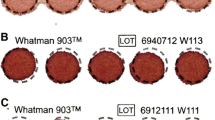Abstract
In this study we present an innovative design idea for a semi-invasive blood sampling, analysis and drug delivery device called “Electronic Mosquito” (“e-Mosquito”). The major building blocks of the device are discussed. The principle of operation is described and its feasibility is demonstrated. The integration of the microsystem is outlined and its practical implementation proposed.











Similar content being viewed by others
References
ANSYS (2004) Simulation software program, Ver. 7, http://www.ansys.com, Ansys Inc.
Griss P, Stemme G (2003) Side-opened out-of-plane microneedles for microfluidic transdermal liquid transfer. J Microelectromech Syst 12:296–301
Hendriks FM (2003) A numerical-experimental method to characterize the non-linear mechanical behaviour of human skin. Skin Res Technol 9:274–283
Lauwers E, Suls J, Gumbrecht W, Maes D, Gielen G, Sansen W (2001) A CMOS multiparameter biochemical microsensor with temperature control and signal interfacing. IEEE J Solid-State Circuits 36:2030–2038
MEMSCAP (2003) PolyMUMPs design handbook. Rev.10.0
MicraGem (2003) Introduction to MicraGEM: a silicon-on-insulator based micromachining process, Rev. 2.0
Moore DF, Syms R (1999) Recent developments in micromachined silicon. Electron Commun Eng J 11:261–270
Thielicke E, Obermeier E (2000) Microactuators and their technologies. Mechatronics 10:431–455
VARTA (2003) LFP 25: Lithium manganese dioxide primary microbattery, VARTA Microbattery GmbH, Germany
Wang PMC, MG; Prausnitz MR (2002) Effects of microneedle tip geometry on injection and extraction in the skin, presented at EMBS/BMES Conference, 2002
Wilkins E, Atanasov P (1996) Glucose monitoring: State of the art and future possibilities. Med Eng Phys 18:273–288
Xu K, Li Q, Lu Z, Jiang J (2002) Fundamental study on non-invasive blood glucose sensing. J X-Ray Sci Technol 10:187–197
Acknowledgements
This study is supported in part by the Natural Sciences and Engineering Research Council (NSERC) and the Canadian Microelectronic Corporation (CMC).
Author information
Authors and Affiliations
Corresponding author
Rights and permissions
About this article
Cite this article
Gattiker, G.E., Kaler, K.V.I.S. & Mintchev, M.P. Electronic Mosquito: designing a semi-invasive Microsystem for blood sampling, analysis and drug delivery applications. Microsyst Technol 12, 44–51 (2005). https://doi.org/10.1007/s00542-005-0015-9
Received:
Accepted:
Published:
Issue Date:
DOI: https://doi.org/10.1007/s00542-005-0015-9




